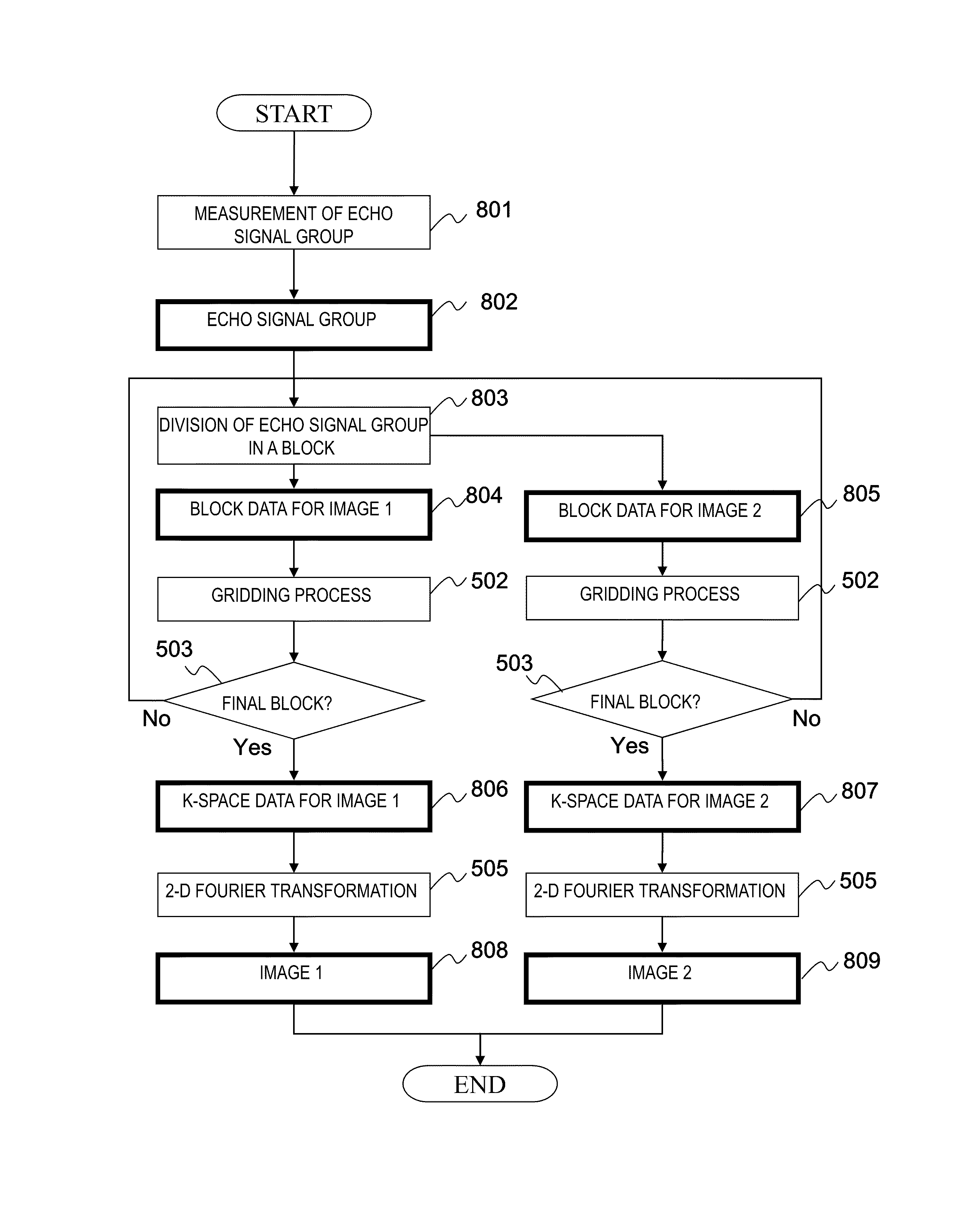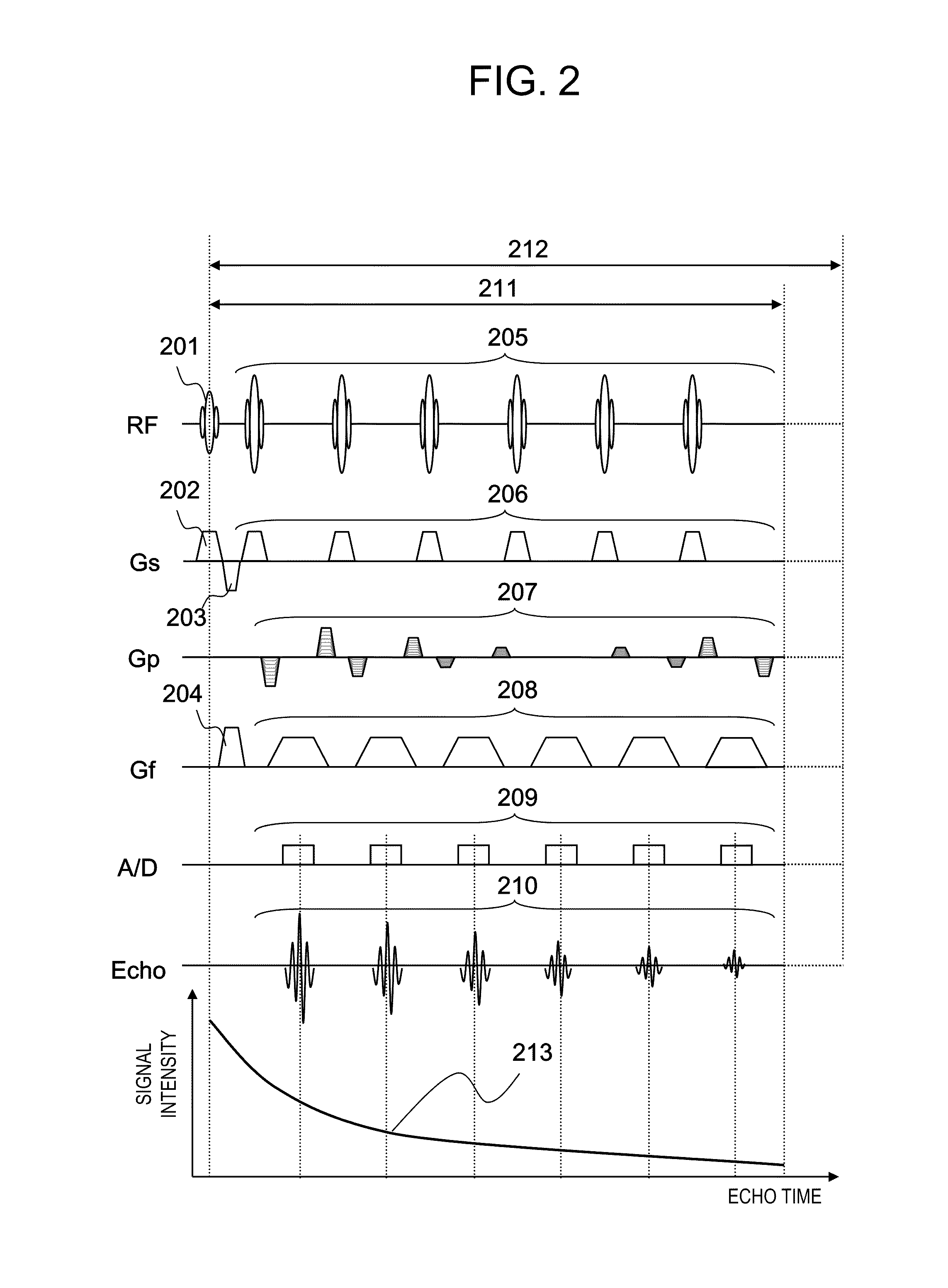Magnetic resonance imaging apparatus and multi-contrast acquiring method
a magnetic resonance imaging and multi-contrast acquisition technology, applied in the field of multi-echo sequence techniques, can solve the problems of increasing the total imaging time, inadequate signal-to-noise ratio, and deteriorating contrast of images obtained by reconstructing such k-space data, so as to reduce imaging time, improve contrast of respective images, and improve image contrast
- Summary
- Abstract
- Description
- Claims
- Application Information
AI Technical Summary
Benefits of technology
Problems solved by technology
Method used
Image
Examples
first embodiment
[0085]Next, the first embodiment of the MRI apparatus and multi-contrast image acquisition method related to the present invention will be described. The present embodiment divides the respective echo signals of one or more blocks measured by the sequence of the hybrid radial method into a plurality of partial echo signal groups, and reconstructs an image respectively having different contrasts using each of the divided partial echo signal groups. Further, upon dividing the echo signal group of one or more blocks, one or more echo signals from among the echo signal group are to be overlapped with two or more of the plurality of partial echo signal groups. The present embodiment will be described below in detail using the attached diagrams.
[0086]First, the outline of the present embodiment will be described referring to FIGS. 6 and 7.
[0087]FIG. 6(a) shows echo signal group 601 in one time of repetition 211 measured by executing the sequence of the hybrid radial method shown in FIG. 4...
second embodiment
[0110]Next, the second embodiment of the MRI apparatus and multi-contrast image acquisition method related to the present invention will be described. While an example that the echo signal group of the block is divided so that the numbers of echo signals to be collected as each partial echo signal group are to be approximately the same as described in the first embodiment, the present embodiment divides the echo signal group of the block, with respect to the echo signal group of one or more blocks, by differentiating the numbers of echo signals to be collected as a partial echo signal group. All but this point is the same as the first embodiment. Only the difference from the first embodiment will be described below based on FIG. 9, and the explanation on the same part will be omitted.
[0111]FIG. 9(a) shows echo signal group 901 in one time of repetition 211 measured by executing the sequence by the hybrid radial method shown in FIG. 4, illustrating the case that 14 echo signals are m...
third embodiment
[0123]Next, the third embodiment of the MRI apparatus and multi-contrast image acquisition method related to the present invention will be described. While an example is described in the first embodiment that an echo signal group in a block is divided by overlapping the same echo signal with a plurality of partial echo signal groups, the present embodiment divides an echo signal group in a block without overlapping the same echo signal with a plurality of partial echo signal groups, i.e. by differentiating the echo signal for every partial echo signal groups. All but this point is the same as the first embodiment. Only differences of the present embodiment from the first embodiment will be described below referring to FIG. 11, and explanation on the same content will be omitted.
[0124]In order not to overlap the same echo signal with a plurality of partial echo signal groups, the present embodiment measures a part of echo signals corresponding to the low-spatial frequency region in t...
PUM
 Login to View More
Login to View More Abstract
Description
Claims
Application Information
 Login to View More
Login to View More - R&D
- Intellectual Property
- Life Sciences
- Materials
- Tech Scout
- Unparalleled Data Quality
- Higher Quality Content
- 60% Fewer Hallucinations
Browse by: Latest US Patents, China's latest patents, Technical Efficacy Thesaurus, Application Domain, Technology Topic, Popular Technical Reports.
© 2025 PatSnap. All rights reserved.Legal|Privacy policy|Modern Slavery Act Transparency Statement|Sitemap|About US| Contact US: help@patsnap.com



